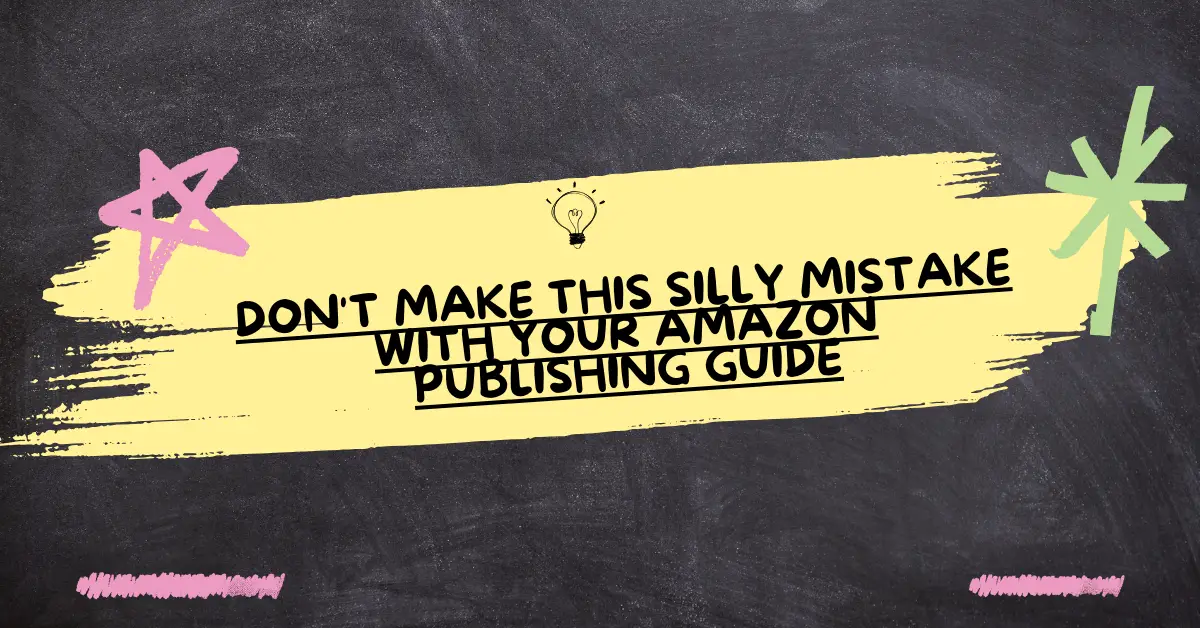Introduction
The Amazon publishing guide provides step-by-step instructions for new authors. Amazon has become one of the most powerful platforms for self-publishing authors, with its Kindle Direct Publishing (KDP) offering an easy, low-cost way to publish digital books. Many aspiring authors are drawn to Amazon’s publishing tools for their accessibility and potential for high earnings. However, there’s one common mistake that many new authors make when publishing their eBooks on Amazon that can significantly hurt their chances of success.
This mistake isn’t about writing skills or lack of creativity. It’s about not understanding the fundamentals of the publishing process on Amazon and failing to use the tools and resources available effectively. With that in mind, let’s dive into this “silly mistake” and explore how to avoid it, as well as provide a comprehensive Amazon publishing guide to help you succeed.
The Silly Mistake: Not Fully Understanding the Amazon Publishing Process
The mistake that many authors make when they first start out on Amazon is not thoroughly understanding the entire publishing process. While KDP offers a straightforward platform for uploading and selling eBooks, there are multiple steps, settings, and strategies involved in ensuring your book reaches its target audience and performs well.
Let’s take a closer look at this mistake and what you need to do instead.
1. Ignoring the Importance of Metadata
One of the biggest mistakes self-published authors make is neglecting the importance of metadata. Metadata refers to the information about your book that appears on its Amazon page. This includes your title, subtitle, book description, keywords, categories, and author name.
Many new authors are so focused on the manuscript itself that they overlook the significance of metadata. However, this information plays a pivotal role in your book’s discoverability and sales. If your metadata isn’t optimized, potential readers may never find your book.
The Correct Approach:
- Title and Subtitle: Ensure your title is clear, descriptive, and contains relevant keywords. Your subtitle should further clarify the topic and draw readers in.
- Book Description: This is your sales pitch. Write an engaging and persuasive description that outlines what the book is about, why it’s valuable, and what readers can expect.
- Keywords: Select the right keywords that potential readers are likely to search for. Use a combination of broad and niche keywords to cover more ground.
- Categories: Choose the right categories for your book. This will help it appear in the right genre sections on Amazon and make it more likely to be recommended to readers.
Optimizing these elements is crucial to making your book discoverable to the right audience.
2. Skipping Professional Editing and Proofreading
Another mistake many authors make is publishing a book without proper editing and proofreading. Some authors believe they can bypass this step by reading through their manuscript a few times or using basic spell check tools. However, these strategies are not sufficient.
A book riddled with errors—whether they’re grammatical mistakes, inconsistencies, or unclear phrasing—will quickly turn off readers. Even if your book is full of great ideas, readers are unlikely to buy or recommend a poorly edited book.
The Correct Approach:
Invest in professional editing and proofreading services. A qualified editor will ensure that your book is polished, coherent, and free of errors. The goal is to produce a book that feels professionally done, even though you’re self-publishing.
3. Neglecting the Book Cover
A book cover is your first opportunity to make a strong impression on potential readers. When it comes to Amazon publishing, the cover is crucial for standing out in a crowded market. Many authors make the mistake of designing their own cover or using a free, low-quality template. This is a major misstep.
While the content of your book is the most important part, your cover is what will make the first impression. A professional, high-quality cover that visually represents the book’s content can significantly increase your click-through rate and help drive sales.
The Correct Approach:
Consider hiring a professional graphic designer who specializes in book covers. Your cover should be eye-catching, clear, and professional. It should reflect the tone and genre of your book and resonate with your target audience.
4. Choosing the Wrong Price for Your Book
Pricing is a critical aspect of your Amazon publishing strategy. Many new authors make the mistake of either underpricing or overpricing their book. Pricing it too low can hurt your credibility and make your book seem cheap, while pricing it too high can scare potential buyers away, especially if you’re an unknown author.
Amazon offers two main royalty options: 35% and 70%. For books priced between $2.99 and $9.99, you can earn 70% royalties, which is the most beneficial pricing range for eBooks. However, pricing your book outside of this range may result in a lower royalty rate.
The Correct Approach:
Research other books in your genre and see how they are priced. Start with a competitive price that offers value to readers while still ensuring you earn a fair royalty. Many successful self-published authors price their books in the $2.99 to $9.99 range to take advantage of the higher royalty rate.
5. Not Leveraging Amazon’s Marketing Tools
Amazon offers several marketing tools to help promote your book, including Kindle Unlimited (KU), Kindle Countdown Deals, and Amazon Advertising. Many authors, particularly those new to self-publishing, fail to take advantage of these features, thinking that simply publishing their book will generate sales.
The truth is, even though Amazon is a huge marketplace, it’s also highly competitive. Without proper promotion, your book might get lost among millions of other titles.
The Correct Approach:
Use Amazon’s marketing tools to increase visibility. You can enroll your book in Kindle Unlimited, run limited-time promotions, and use Amazon Ads to target specific keywords or audiences. These tools help increase your book’s exposure and can result in more sales.
6. Not Building an Author Platform or Following
One of the most common mistakes authors make when publishing on Amazon is not investing in building an author platform. This means building an online presence, such as a website, blog, email list, or social media profiles, where you can engage with your audience and promote your work.
Without an author platform, it can be difficult to generate interest in your book or build a loyal reader base. Many authors assume that Amazon will do all the marketing, but this is far from the truth.
The Correct Approach:
Start building your author platform early. Engage with readers through social media, offer free content like blog posts or newsletters, and interact with your audience. Cultivating a loyal following before publishing your book can give you a head start when it comes to marketing and promoting your book.
FAQs About Amazon Publishing
1. Do I need an ISBN to publish on Amazon?
No, Amazon provides a free ASIN (Amazon Standard Identification Number) for your eBook. You only need an ISBN if you want to distribute your book outside of Amazon.
2. How can I promote my book on Amazon?
You can promote your book using tools like Kindle Unlimited, Kindle Countdown Deals, Amazon Advertising, and offering promotional discounts. Additionally, creating an author platform on social media and building an email list can help market your book.
3. How do I format my book for Amazon?
Ensure your manuscript is formatted according to Amazon’s guidelines. Common formats include .doc, .docx, and .epub files. You can also use Kindle Create, a free tool offered by Amazon, to format your book easily.
4. How do I choose the right keywords for my book?
Keywords should be relevant to your book’s content and genre. Use tools like Kindle Spy or KDP Rocket to research popular keywords in your niche. Choose a mix of broad and niche keywords to optimize visibility.
5. What are royalties on Amazon publishing?
If your book is priced between $2.99 and $9.99, you’ll receive 70% royalties. For books priced outside of this range, you’ll earn 35% royalties.
Conclusion
Avoiding these common mistakes is essential for authors looking to succeed in the Amazon digital book publishing space. By understanding the fundamentals of the publishing process and taking the time to properly optimize your book’s metadata, cover, price, and promotion, you will increase your chances of success. Publishing on Amazon is an incredible opportunity, but it requires attention to detail and dedication to producing the best possible product. By following this guide, you’ll be on your way to successfully navigating Amazon’s publishing landscape and reaching your goals as a self-published author.



